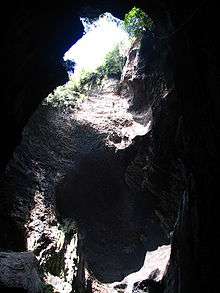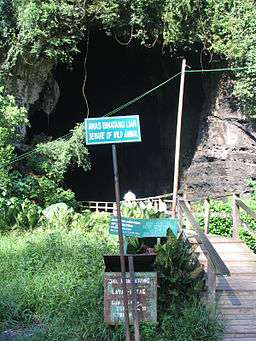Gomantong Caves
| Gomantong Caves | |
|---|---|
|
Entrance to the caves. | |
| Coordinates | 5°31′0″N 118°4′0″W / 5.51667°N 118.06667°WCoordinates: 5°31′0″N 118°4′0″W / 5.51667°N 118.06667°W |
| Discovery | 1930 |
| Entrances | 1 |

The Gomantong Caves are an intricate cave system inside Gomantong Hill. The hill is the largest limestone outcrop in the Lower Kinabatangan area, Sandakan division, in the Malaysian state of Sabah, on Borneo island. Situated in a Sabah Forestry Department forest reserve, the caves and the surrounding area are a protected area for wildlife, especially orangutans. The limestone hill is also the only known site for the endangered land snail Plectostoma mirabile. Investigation of the guano deposits were first made in 1889 by J.H. Allard of the China Borneo Company, and the caves were first mapped by P. Orolfo in 1930. Detailed re-mapping and laser-scanning of the caves was conducted in 2012 [1] and July 2014 http://gomantong.photofolio.org
The main cave system is divided into two parts: the more accessible Simud Hitam (Black Cave), and the larger Simud Putih (White Cave) which lies above. The names refer to the main type of nests produced by swiftlets in each cave. The cave system is home to many other animals, including massive populations of cockroaches and bats. Outside one can see crested serpent eagles, kingfishers, and Asian fairy bluebirds. Access is in the form of a wooden walkway circuiting the interior.
For centuries, the caves have been renowned for their valuable edible swiftlet nests, which are harvested for bird's nest soup. The most valuable of the nests, the white ones, can sell for very high prices.
The birds' nest collection is an ancient tradition, and the trading of these nests has been done since at least 500 AD. Twice a year, from February to April and July to September, locals with licenses climb to the roof of the caves, using only rattan ladders, ropes, and bamboo poles, and collect the nests. The first collection takes place early in the breeding season before the swiftlets lay their eggs. The birds then make another nest in which they finally lay their eggs. After the young have fledged, the second collection is made. Care must be taken to assure that the nests are collected only after the young swiftlets have abandoned these nests. These individuals are very much in demand by the people and communities that hold the Government's harvesting licenses. Edible birds' nests are protected under the Birds' Nest Ordinance and the Forest Enactment of 1968. Heavy fines and penalties are imposed on unlicensed collectors.
The bat population is dominated by a colony of the Wrinkle Lipped Free-tailed bat, Chaerephon plicatus, whose nightly exodus is a popular tourist attraction. The population size, which has been widely exaggerated in the past, was counted at between 275,000 and 276,000 in 2012 [2] There are also bat hawks that linger not far from the scene and prey specifically on the bats as they leave their roost.
A number of short video documentaries covering aspects of the natural history of the Gomantong caves are available (see External Links)
Simud Hitam

Simud Hitam (Black Cave) is the more accessible of the two caves, only a few minutes' walk from the entrance building, and it is open to the general public. Its ceiling can reach 40–60 meters high. It is the source of the less-valuable "black saliva" nests. These contain both feathers and saliva and require cleaning afterwards.
Simud Putih
Simud Putih (White Cave) is the larger of the two caves, and also the more technical; it is not open to the general public, and access requires appropriate caving equipment and experience. It is where the more valuable "white saliva" nests of the swiftlets are found, and is reached by a steep 30 minute climb further up the mountains. The main entrance is located above and adjacent to the main "lighthole" at the back of Simud Hitam.
References
- Wilford, G. E. 1964. The Geology of Sarawak and Sabah caves. Geological Survey, Borneo Region, Malaysia. 181p.
External links
- Gomantong Caves, an article about the caves
- SabahTravelGuide.com
- VirtualMalaysia.com
- Simud Hitam (The Black Cave)
- Science at Gomantong Caves
- Mapping and Video documentation of Gomantong Caves
- https://www.youtube.com/watch?v=rq_cAzAKpKI Resource competition in the Gomantong guano.
- https://www.youtube.com/watch?v=RlmIOvcqong Life and death in the Gomantong caves.
- https://www.youtube.com/watch?v=CO2TmZDk6Hw&feature=youtu.be The Gomantong ecosystem
- https://www.youtube.com/watch?v=U-ruJ1P2NrY&feature=youtu.be The Swiftlets of Gomantong
- https://www.youtube.com/watch?v=hqGG62OWhX0&feature=youtu.be Unusual geomorphology of Gomantong caves
- https://www.youtube.com/watch?v=HoASTeKexdA&feature=youtu.be Spider Hawk wasps at Gomantong
- http://opisthostoma.lifedesks.org/pages/701
- https://www.youtube.com/watch?v=MSs97dNomeQ Animated 3D model of both Simud Hitam and Simud Puteh
| ||||||||||||||||||||||||||||||||||||||||||||||||||
